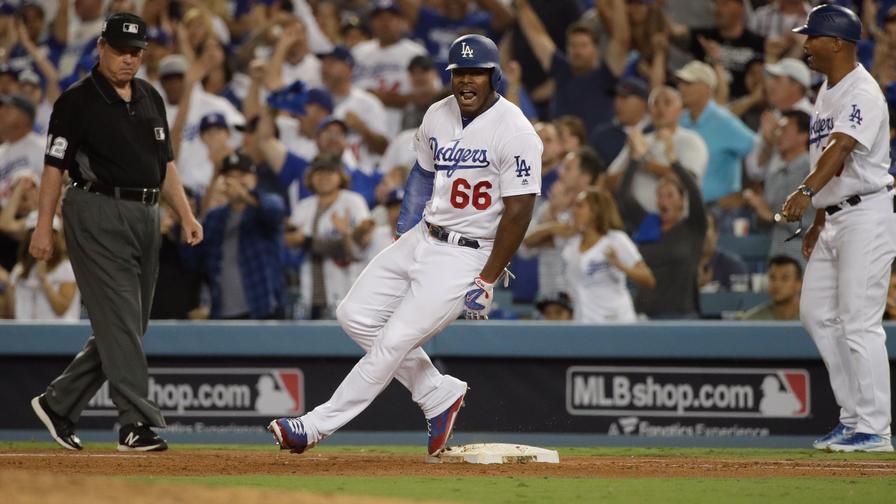Yasiel Puig's Season Just Keeps Getting Better

To say Yasiel Puig burst onto the scene as a rookie would be an understatement. Puig slashed a gaudy .319/.391/.534 with 19 home runs in 2013, his rookie campaign. He had a 160 wRC+, and 4.1 fWAR in 432 plate appearances (104 games) that year.
He followed it up with a stellar 2014 campaign in which he slashed .296/.382/.480. The power was down, as evidenced by his .480 slugging percentage and home run total of 16, but he was still able to put up a 148 wRC+ and 5.4 fWAR. He did that in 640 plate appearances (148 games).
After those debut years, he looked like a surefire superstar for the Los Angeles Dodgers, but he really struggled the next two seasons.
Puig was hampered by a litany of hamstring injuries in 2015 and 2016, and he had two average-at-best seasons in those years. The 2015 campaign saw him earn 1.5 fWAR and a 111 wRC+ in 311 plate appearances (79 games), and 2016 saw him hit career lows in wRC+ (101) and fWAR (1.0) over 104 games (368 plate appearances).
However, Puig got healthy for 2017, and he put together a very good season for the Dodgers. And he's taken it to a new level in the playoffs.
A Return to Form (Of Sorts)
While Puig did not have as dominant of a season as he did in 2013 and 2014, he was a valuable piece of the puzzle for the 2017 Dodgers.
He triple-slashed .263/.346/.487, his best since his first two seasons. He easily set a career high in home runs with 28, and he had a 117 wRC+and 2.9 fWAR. That wRC+ and fWAR put him ninth among all right fielders. While it was not the incredible numbers he came into the league with, he still was a well above-average right fielder.
The biggest change Puig made this season (outside of having healthy hamstrings for the first time in two years) are seen in his walk rate and strikeout rate, as the chart below shows.
| Year | Walk Rate | Strikeout Rate |
|---|---|---|
| 2013 | 8.3% | 22.5% |
| 2014 | 10.5% | 19.4% |
| 2015 | 8.4% | 21.2% |
| 2016 | 6.5% | 20.1% |
| 2017 | 11.2% | 17.5% |
Puig had a career-high walk rate this year, and he coupled that with a career-low strikeout rate. That gave him a career low in swinging-strike rate (10.6%) and a career-high contact rate (76.9%). He put the ball in play more than he usually did, and it helped give him his best season since 2014.
Something to keep an eye on next year is his .274 BABIP from this year -- a BABIP that low helped cap his season at a good level rather than a great one. It was also a career-low BABIP for him; if he can normalize his BABIP, he may be in store for a monster 2018 campaign, as long as he keeps putting the ball in play as much as he did this season (and staying healthy).
This campaign was his best season in a while, but it pales in comparison to what he has done this postseason.
An Excellent Postseason
Puig has been absolutely unbelievable in October for the Dodgers, as they clinched their first World Series appearance since 1988. Puig has played in all eight games in the playoffs, and he has been nothing short of unbelievable.
In the Dodgers' 3-0 sweep of the Arizona Diamondbacks in the Divisional Round, Puig slashed .455/.538/.727. He kept it going in the National League Championship Series against the Chicago Cubs, slashing .389/.500/.611 as the Dodgers took the series, 4-1.
Overall, Puig has a robust .414/.514/.655 slash in these playoffs, earning him a 210 wRC+. He has been 110% better than the average major league player during this hot stretch.
Not only has Puig been playing incredibly well, he has been extremely fun to watch. Whether he is licking his bat, unleashing top-tier bat flips, or doing this weird dance in the batter's box, Puig has been a ton of fun to watch this postseason.
Emotion like that is good for the game, and at bats like his are very good for the Dodgers in their quest for their seventh World Series title. Per our models, LA is a slight favorite over the Houston Astros, and as has been the case so far, if the Dodgers win, Puig will likely have a key role in their success.
















